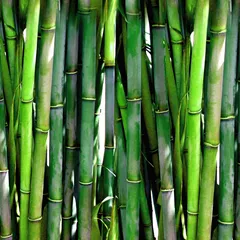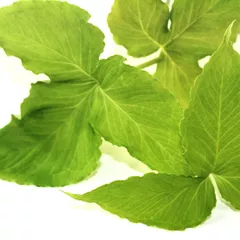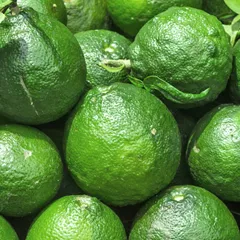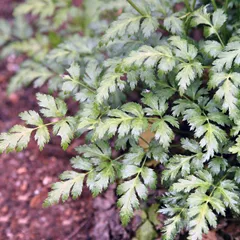Zhu Ru
English: Bamboo shavings
Chinese: 竹茹
Parts used: Dried middle shavings
TCM category: Cool herbs that transform Phlegm and stop Cough
TCM nature: Cool
TCM taste(s): Sweet
Organ affinity: Gallbladder Stomach Lung
Scientific name: Bambusa tuldoides Munro, Sinocalamus beecheyanus or Phyllostachys nigra
Other names: Caulis Bambusae in Taeniam
Use of Zhu Ru (bamboo shavings) in TCM
Please note that you should never self-prescribe TCM ingredients. A TCM ingredient is almost never eaten on its own but as part of a formula containing several ingredients that act together. Please consult a professional TCM practitioner, they will be best able to guide you.
Preparation: Remove the bamboo's outer bark, shave very thin stripes and let them dry
Dosage: 4.5 - 9 grams
Main actions according to TCM*: Clears Phlegm-Heat in the Lungs. Clears Heat in the Stomach and stops vomiting. Cools the Blood and stops bleeding.
Primary conditions or symptoms for which Zhu Ru may be prescribed by TCM doctors*: Restlessness Vomiting Palpitations Insomnia Sputum Coughing Bloody sputum Nosebleed
Contraindications*: This herb should not be used in cases of Spleen Deficiency or cough caused by Cold.
Common TCM formulas in which Zhu Ru is used*
Ju Pi Zhu Ru Tang
Source date: Essentials from the Golden Cabinet
Number of ingredients: 6 herbs
Formula key actions: Directs rebellious Qi downward. Stops hiccup. Augments Qi. Clears heat.
Conditions targeted*: Morning sicknessIncomplete pyloric obstruction and others
Zhu Ru is a king ingredient in Ju Pi Zhu Ru Tang. Like the name indicates, it means it has more power than other ingredients in the formula.
In Ju Pi Zhu Ru Tang, Zhu Ru clears Heat, calms the Stomach, and stops hiccup
Wen Dan Tang
Source date: 1174 AD
Number of ingredients: 8 herbs
Formula key actions: Clears Phlegm. Clears Gallbladder. Regulates Qi. Harmonizes the Stomach.
Conditions targeted*: HypertensionAngina and others
Zhu Ru is a deputy ingredient in Wen Dan Tang. This means it helps the king ingredient(s) treat the main pattern or it serves to treat a coexisting pattern.
In Wen Dan Tang, Zhu Ru enters the Stomach to expel Heat and stop nausea, and the Gallbladder to calm the Mind, release Stagnation, and alleviate irritability.
Hao Qin Qing Dan Tang
Source date: Qing Dynasty
Number of ingredients: 10 herbs
Formula key actions: Clears Heat and relieves acute conditions of the Gallbladder. Relieves acute Damp-Heat syndromes. Resolves Phlegm. Harmonizes the Stomach.
Conditions targeted*: CholecystitisIcteric hepatitis and others
Zhu Ru is a deputy ingredient in Hao Qin Qing Dan Tang. This means it helps the king ingredient(s) treat the main pattern or it serves to treat a coexisting pattern.
In Hao Qin Qing Dan Tang, Zhu Ru drains Heat from the Gallbladder and Stomach and stops the vomiting.
Huang Lian Wen Dan Tang
Source date: 1852 AD
Number of ingredients: 7 herbs
Formula key actions: Clears Hot Phlegm. Clears Gallbladder Heat. Regulates Qi. Harmonizes the Stomach.
Conditions targeted*: HypertensionAngina and others
Zhu Ru is a deputy ingredient in Huang Lian Wen Dan Tang. This means it helps the king ingredient(s) treat the main pattern or it serves to treat a coexisting pattern.
In Huang Lian Wen Dan Tang, Zhu Ru enters the Stomach to expel Heat and stop nausea, and the Gallbladder to calm the Mind, release Stagnation, and alleviate irritability.
Di Tan Tang
Source date: 1470 AD
Number of ingredients: 9 herbs
Formula key actions: Removes Phlegm. Opens the sensory orifices. Tonifies Qi.
Conditions targeted*: Cerebrovascular accidentSeizure disorder and others
Zhu Ru is an assistant ingredient in Di Tan Tang. This means that it either serves to reinforces the effect of other ingredients or it moderates their toxicity.
In Di Tan Tang, Zhu Ru transforms Phlegm. It is also slightly cooling in nature so that it can balance the warming properties of most of the other ingredients of the formula.
Ling Jiao Gou Teng Tang
Source date: Qing dynasty
Number of ingredients: 10 herbs
Formula key actions: Cools the Liver. Extinguishes Wind. Increases Fluids. Relaxes the sinews.
Conditions targeted*: EncephalitisMeningitis and others
Zhu Ru is an assistant ingredient in Ling Jiao Gou Teng Tang. This means that it either serves to reinforces the effect of other ingredients or it moderates their toxicity.
In Ling Jiao Gou Teng Tang, Zhu Ru clears Heat and transforms Phlegm.
Key TCM concepts behind Zhu Ru's properties
In Traditional Chinese Medicine (TCM), Zhu Ru belongs to the 'Cool herbs that transform Phlegm and stop Cough' category. In TCM Phlegm is a condition of Stagnation of Fluids which tends to start in the Spleen and then goes to the Lungs. If this overly accumulates it thickens and becomes pathological Phlegm. Phlegm, being a form of Stagnation, often starts as being Cool and transforms to Hot as the condition progresses. The herbs in this category are Cold in nature so they treat the later stages of the Stagnation: Hot and Dry-Phlegm with symptoms such as cough, goiter or scrofula.
As suggested by its category Zhu Ru is Cool in nature. This means that Zhu Ru tends to help people who have too much 'Heat' in their body, although with less effect than a plant that would be Cold in nature. Balance between Yin and Yang is a key health concept in TCM. Those who have too much Heat in their body are said to either have a Yang Excess (because Yang is Hot in nature) or a Yin deficiency (Yin is Cold in Nature). Depending on your condition Zhu Ru can help restore a harmonious balance between Yin and Yang.
Zhu Ru also tastes Sweet. The so-called 'Five Phases' theory in Chinese Medicine states that the taste of TCM ingredients is a key determinant of their action in the body. Sweet ingredients like Zhu Ru tends to slow down acute reactions and detoxify the body. They also have a tonic effect because they replenish Qi and Blood.
The tastes of ingredients in TCM also determine what Organs and Meridians they target. As such Zhu Ru is thought to target the Gallbladder, the Stomach and the Lung. Similar to modern medicine, in TCM the Gallbladder stores and releases bile produced by the Liver. It also controls the emotion of decisiveness. The Stomach on the other hand is responsible for receiving and ripening ingested food and fluids. It is also tasked with descending the digested elements downwards to the Small Intestine. In addition to performing respiration, the Lungs are thought in TCM to be a key part of the production chain for Qi and the Body Fluids that nourish the body.
Use of Zhu Ru as food
Zhu Ru is also eaten as food.















